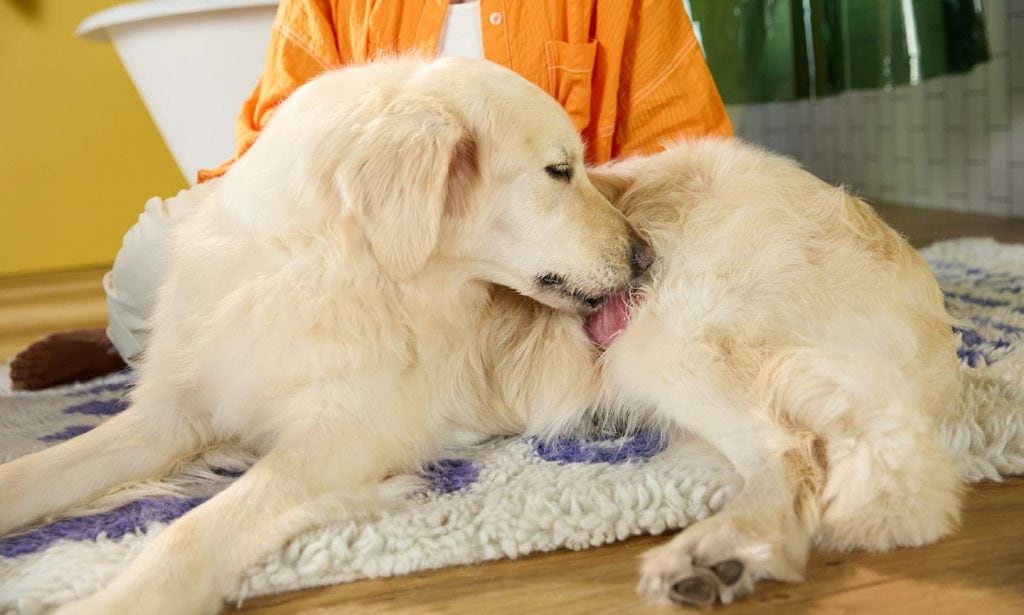If your dog has developed a red, itchy patch of skin that they just won’t seem to leave alone, chances are you’re dealing with a hot spot.
But don’t fret! Dog hot spots are a common skin condition, and they are usually easy to treat and prevent—if you know what steps to take.
Here’s everything you need to know about hot spots on dogs.
In This Guide:
What Are Hot Spots on Dogs?
Also known as pyotraumatic dermatitis or acute moist dermatitis, a hot spot is a skin lesion that’s characterized by:
- Redness and skin irritation
- Hair loss (often)
And hot spots are likely found:
- At the base of the tail
- At the back of the legs
- At the groin
- Around the neck
Hot spots are self-inflicted by your dog, created when they compulsively chew at a certain part of their body. They’re painful for your pup, and they’re also prone to secondary skin infections.
What Do Hot Spots Look Like on Dogs?
It’s usually possible to recognize a hot spot just by examining your dog’s skin:
- The hot spot is often a roughly round or oval area where the fur is thin or missing altogether.
- Inside this patch of hair loss, you may find spots that are red and oozy (newer hot spots) or darker and crusty (older hot spots that may be starting to heal).
Dogs can have more than one hot spot at a time.
What Causes Hot Spots on Dogs?
The most common causes of hot spots on dogs include:
- Flea bite hypersensitivity (allergy to flea bites)
- Other hypersensitivities, including food allergies or seasonal allergies (atopic dermatitis)
- Ear infections
- Boredom, anxiety, or a compulsive disorder
- Anal gland itching or pain
- Skin fold infections
How To Treat Dog Hot Spots
1. Contact Your Veterinarian
Different causes require different treatments, and your veterinarian is the best person to determine your dog’s underlying cause and appropriate treatment plan. This is especially important if:
- Your dog won’t stop scratching
- Your dog is shaking their head
- Your dog has hives
- The hot spots keep reoccurring.
Veterinarians can also prescribe medications that will help your dog get relief sooner.
Your vet’s advice may vary, but in general, you can take the following steps to help your dog’s hot spot.
2. Clip the Hair Around the Hot Spot
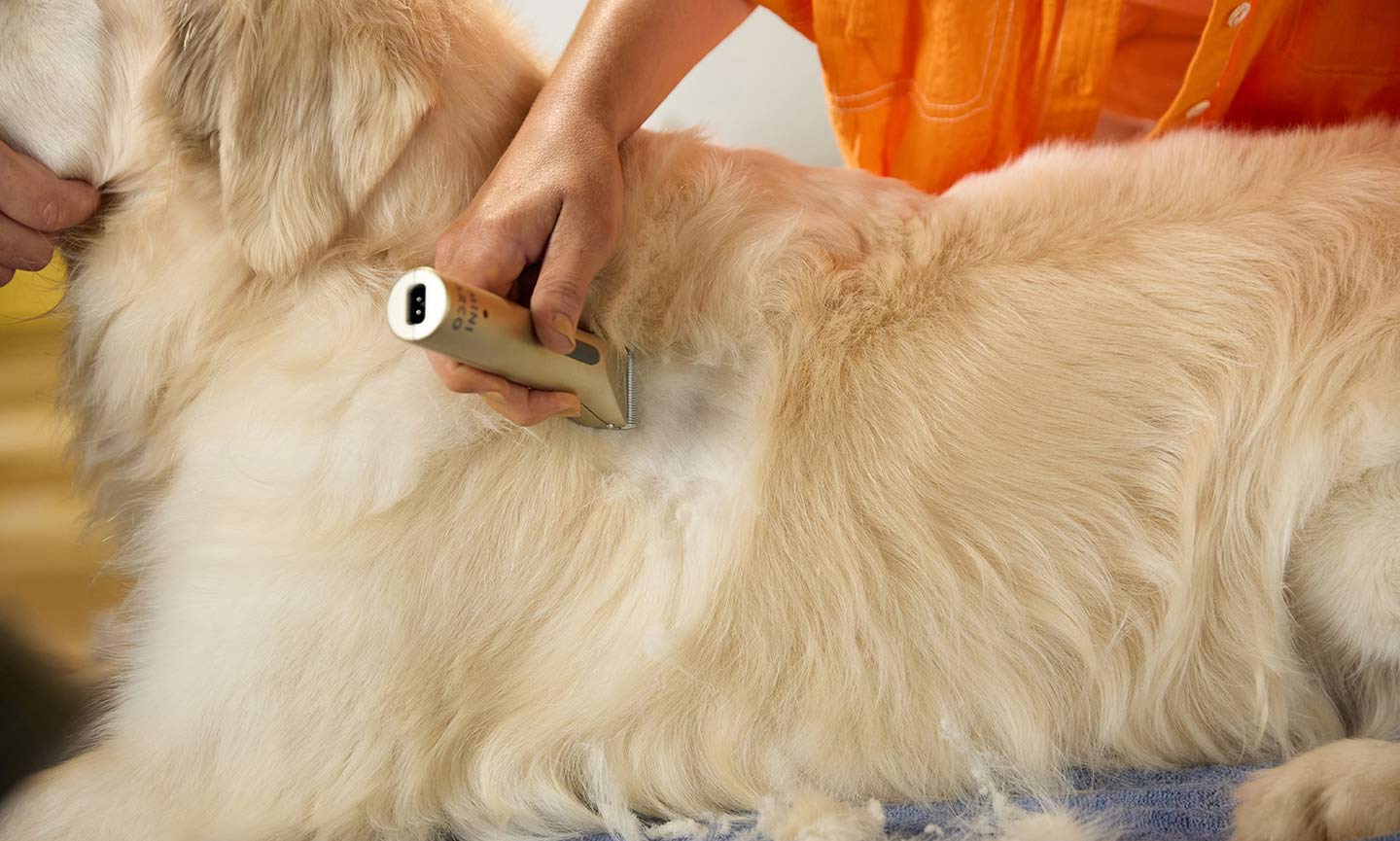
Photo: Chewy
Use high-quality clippers to carefully trim the hair around the spot. This will prevent matted fur and excessive moisture from building up and causing further problems.
Other important tips include:
- Do not clip the hot spot itself, as this will be painful for your dog.
- Talk gently to your dog and use precaution to avoid getting bitten. A hot spot is painful and itchy, and your dog may not like what you are doing. If necessary, ask for help from your veterinarian.
3. Gently Clean the Hot Spot
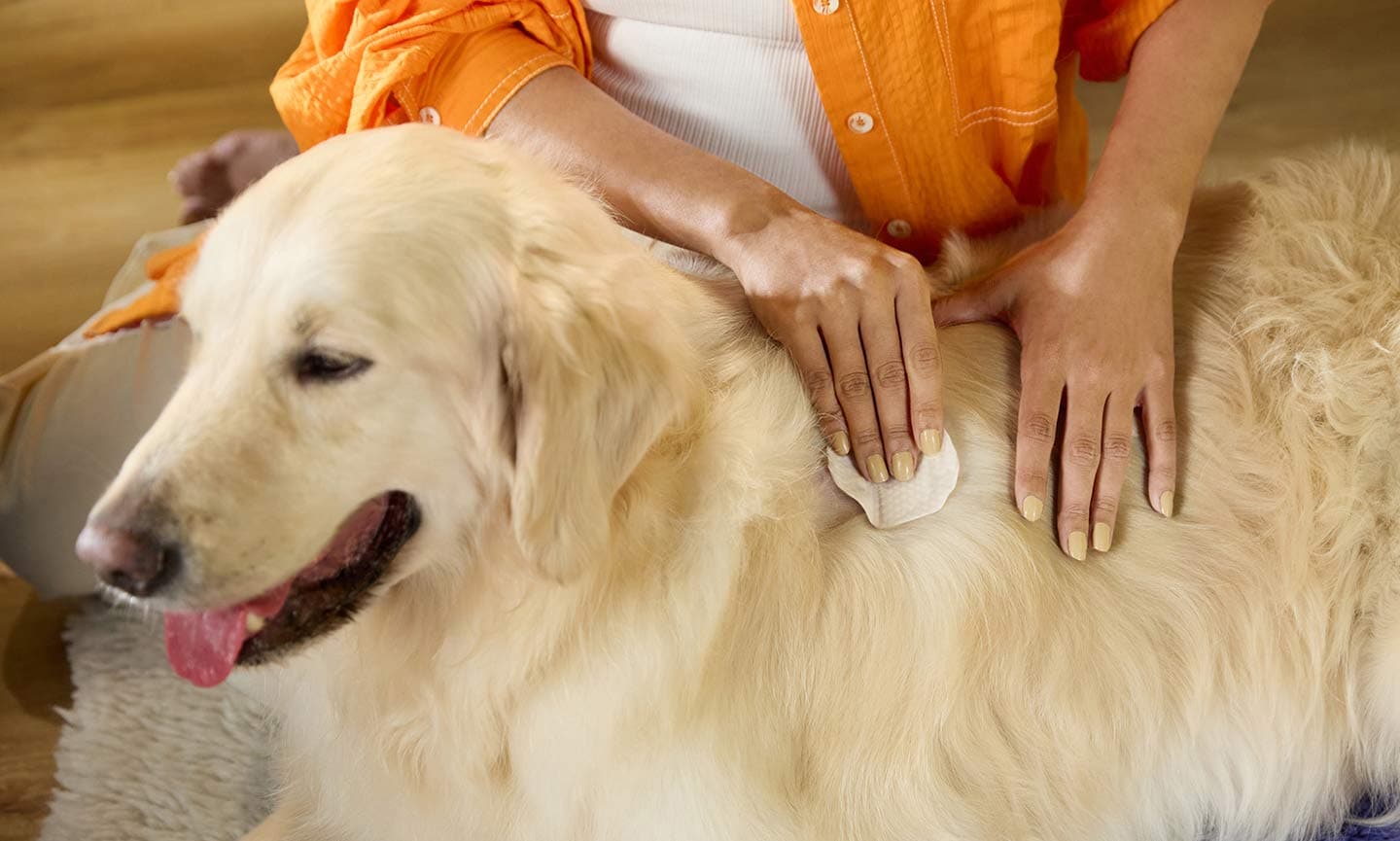
Photo: Chewy
Gently apply a mild antiseptic formulated for pets (like chlorhexidine) to the hot spot. Here are some tips:
- If your antiseptic comes in a bottle of liquid, add some to a gauze square and then apply to the hot spot.
- Dab—don’t wipe—and remember to be gentle as this may also be painful for your dog.
- Avoid products that contain alcohol because that will sting.
Antiseptics can inhibit and kill bacterial skin infections, but some antiseptics can slow healing, so be sure to follow the product instructions for how often to use it.
4. Apply a Topical Treatment
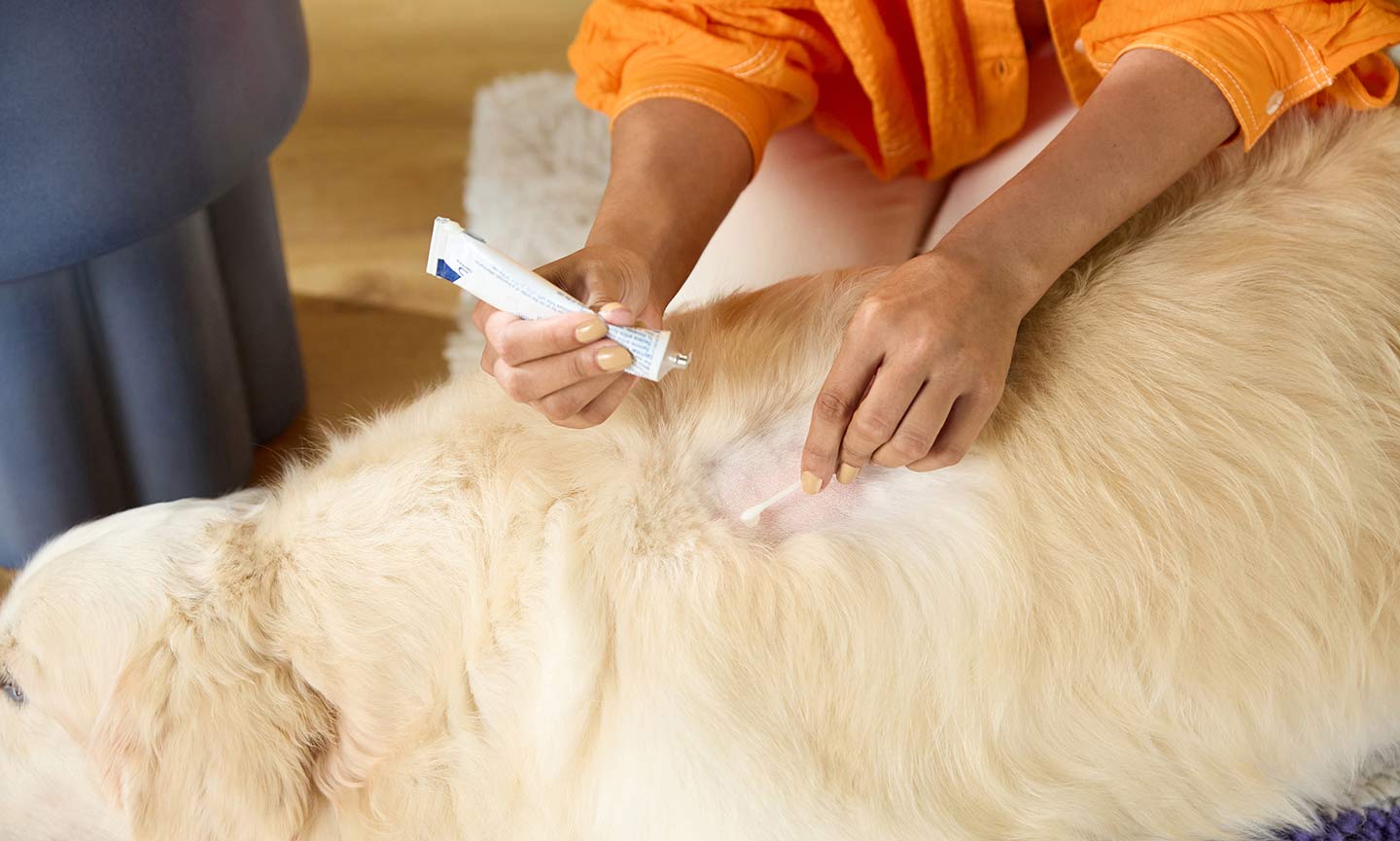
Photo: Chewy
Using a clean cotton swab, gently apply the topical treatment to your dog’s hot spot.
Continue applying the treatment according to its instructions until all of these occur:
- The hot spot is no longer red or oozing
- Your dog is no longer itchy
- The skin appears to be healing
- The hair starts regrowing
A number of creams, ointments, and lotions are available to treat hot spots. The most effective treatments are:
- Antibacterial
- Anti-inflammatory
- Contain a steroid
- Contain antibiotics
- Soothing and protective
Your vet will be able to prescribe the best treatment for your pet. Prescription-strength treatments from your veterinarian are usually more effective than relying on over-the-counter products alone.
5. Place an Elizabethan Collar on Your Dog
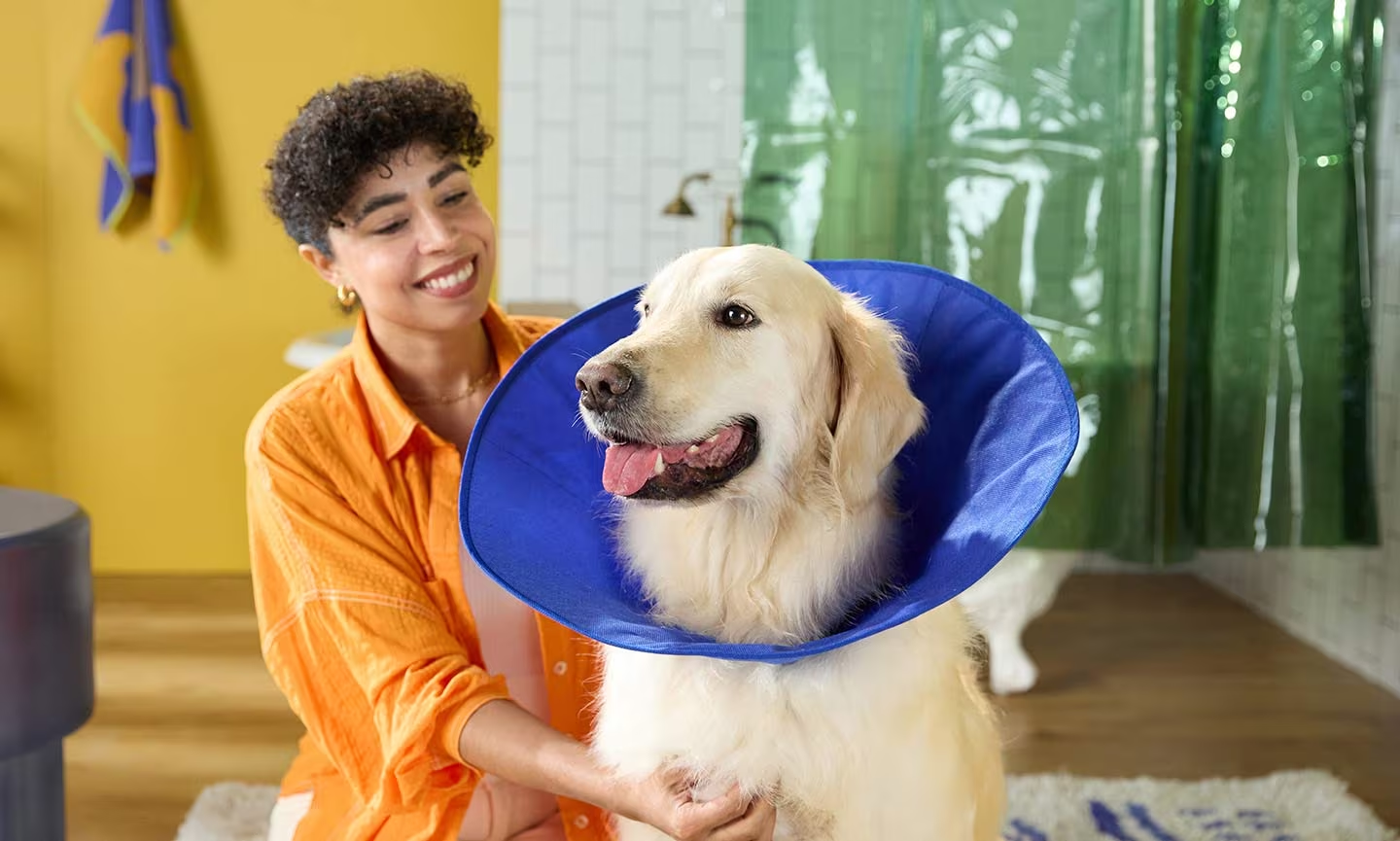
Photo: Chewy
An Elizabethan collar, aka a recovery cone or cone collar, can prevent your dog from licking the hot spot—and just as importantly, licking the medication off the hot spot.
This is an important part of treatment, because the hot spot will take longer to heal or may get worse if the dog is allowed to lick it.
Keep these tips in mind:
- Keep the recovery cone on your dog whenever you’re not able to closely supervise them. You can take it off when you are cuddling together, for instance, or taking a leashed walk.
- Watch your dog closely and prevent them from licking or chewing at the hot spot at all times when the collar is off.
- Use a recovery suit if your dog is unhappy or uncomfortable in a recovery cone (or if they’ve learned to Houdini their way out of it!).
6. Monitor Your Dog for Improvement

Photo: Chewy
Check your dog’s hot spot daily to make sure it’s getting better. Signs of healing include:
- Decreased redness and oozing; the skin “dries up”
- Hot spot develops crusting or a scab
- Dog seems comfortable and isn’t trying to bite the hot spot; less itchiness
- Hair begins to regrow
Sometimes it can be hard to tell if a hot spot is improving. One way to keep track is to take a picture of the hot spot once a day for comparison.
Home Remedies for Dog Hot Spots
If you catch a hot spot early and your pet is uncomfortable and has to wait a few days to be seen by their vet, you can start cleaning and treatment it at home.
However, make sure your vet knows what products you plan to use at home because some products can interfere with skin testing.
Follow these steps:
- Gently clip the fur from around the hot spot to let you see how extensive the problem is and to help the area dry out.
- Clean the area with cool water and mild hand soap (Cetaphil or Dove, for example). Pat the skin dry with a clean paper towel and then let it thoroughly air dry. Repeat once daily.
- Apply a medicated wipe or spray that includes antifungal and antibiotic ingredients, like Douxo S3 PYO wipes.
- Use a cone collar to help prevent your dog from licking or scratching the hot spot.
What Do the Dog Hot Spot Healing Stages Look Like?
Hot spots will start to heal once any infection that is present is gone and the itching goes away. With appropriate treatment, healing occurs in three stages:
- First, the redness and ooziness will lessen and eventually disappear, leaving behind a patch of skin that may be partially or fully covered with something that looks like a crust or scab. This generally takes three to seven days.
- Then, the crusts and scabs will loosen and fall off, which usually takes another five days or so. At this point, the skin underneath is usually pink or darker than normal.
- Finally, the skin’s color will return to normal, and the hair will gradually regrow. Complete hair regrowth may take a month or more.
Talk to your veterinarian if your dog’s hot spots fail to improve or initially get better but then begin to worsen again.
How Do I Prevent Hot Spots on My Dog?
While hot spots are a pain (literally), there are measures you can take to reduce the likelihood that your dog will suffer from them.
- Use an effective flea treatment on all pets in the household. Most dog hot spots are caused by a flea allergy—even one flea bite in an allergic dog can cause significant itching and a rash of hot spots to appear. If you have a heavy flea infestation in your house or yard, then you will need to treat the environment for fleas as well.
- Apply ear drops that dry and balance your dog’s ears after swimming or baths to prevent ear infections. It also helps to put cotton balls in your dog’s ears during baths or swimming (don’t forget to remove them!).
- Decrease boredom with interactive toys or food puzzles if your dog is licking or chewing excessively because they are bored or have behavioral issues. Increasing training and exercise is also recommended. Visit a veterinary behaviorist for more severe compulsive disorders.
- Clean skin folds on the face or around the tail regularly with an antiseptic wipe.
- Have a trained professional express your dog's anal glands, and work with your veterinarian to figure out why your dog needs help expressing their glands so often.
Expert input provided by Jennifer Coates, DVM, a veterinarian consultant in Fort Collins, Colorado.
This content was medically reviewed by Kelly Gold, DVM, a Chewy veterinarian.
Keep Your Dog Healthy:
Share:
